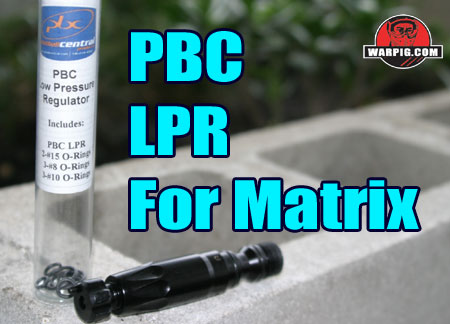  |
|
|
|
|
|
|
  |
|
|
|
|
|
|

What
do you think?
|

PBC LPR By Bill Mills - Sept 2004 When released in 2000, the Matrix turned a lot of heads with its quiet, low pressure operation. Along with a reputation fore being quiet and fast shooting, it was known as a gas hog. It wasn’t long (literally months) before custom shops were modifying the Matrix with low-pressure regulators designed originally for the Autococker. The original Limited Edition Matrix used the same gas supply to both propel the paintball and move the bolt, which serves as the core of the paintgun’s spool valve. The gas pressure going into the gun had to be low in order to keep from overpressuring the solenoid valve which takes electrical signals from the circuit board and directs gas to close the bolt and fire the paintgun.
When Paintball Central introduced their Matrix LPR, they eliminated the need for an external hose. Instead routing all the air through a transfer spool built into the base of the regulator. PBC’s LPR became standard equipment for the LCD Matrix when it was produced by Generation E. It remains available as an upgrade accessory for owners of the earlier Limited Edition and LED model Matrixes.
Adjusting the LPR is slightly more complex. Some on-line guides incorrectly recommend screwing the LPR’s adjuster knob all the way in as a starting point. This is a mistake. If the vertical regulator on the Matrix is adjusted too high, the LPR will allow any pressure to flow through it and damage the solenoid valve. Instead, the LPR’s adjuster knob should be backed out. Proper adjustment requires use of a chronograph (and paint and goggles.) When the Matrix is gassed up and activated, it will not fire when the trigger is pulled because the LPR will not yet be feeding gas to the solenoid valve. The LPR is then adjusted inward a quarter turn at a time and test shots taken without paint until the pressure is high enough that the Matrix is shooting reliably. Then, using paint and the chronograph, the Matrix is fired, and the LPR turned up, until turning it up produces a velocity increase of 5 feet per second or less. A small hex screw in the adjuster knob is then used to lock the adjustment in place.
Even at the stock settings, the installation
of the PBC LPR in a standard Matrix produced a noticeable increase in the
number of shots per compressed air tank fill, and more adjustability in
bolt pressure. Further gas efficiency was obtained by combining the
PBC LPR with an LCD bolt, and adjusting timing values to match the new
bolt.
|
| Copyright © 1992-2019
Corinthian Media Services. WARPIG's webmasters can be reached through our feedback form. All articles and images are copyrighted and may not be redistributed without the written permission of their original creators and Corinthian Media Services. The WARPIG paintball page is a collection of information and pointers to sources from around the internet and other locations. As such, Corinthian Media Services makes no claims to the trustworthiness or reliability of said information. The information contained in, and referenced by WARPIG, should not be used as a substitute for safety information from trained professionals in the paintball industry. |